This document studies module-algebra structures of the quantum universal enveloping algebra Uq(sl(m+1)) on the coordinate algebra of quantum n-dimensional vector spaces Aq(n). The main results are:
1) A complete classification is given of Uq(sl(m+1)) module-algebra structures on Aq(3) when m ≥ 2 and ki acts as an automorphism of Aq(3).
2) All module-algebra structures of Uq(sl(m+1)) on Aq(2) are characterized with the same method.
3) The module-algebra structures of Uq(sl(m+1)) on Aq(n)
![Journal of Lie Theory
Volume 25 (2015) 327–361
c 2015 Heldermann Verlag
Uq(sl(m + 1))-Module Algebra Structures
on the Coordinate Algebra of a Quantum Vector Space
Steven Duplij∗
, Yanyong Hong, and Fang Li†
Communicated by K. Schm¨udgen
Abstract. In this paper, the module-algebra structures of Uq(sl(m + 1)) =
H(ei, fi, k±1
i )1≤i≤m on the coordinate algebra of quantum vector spaces are
studied. We denote the coordinate algebra of quantum n-dimensional vector
space by Aq(n). As our main result, first, we give a complete classification of
module-algebra structures of Uq(sl(m + 1)) on Aq(3) when ki ∈ Aut L(Aq(3))
as actions on Aq(3) for i = 1, · · · , m and m ≥ 2 and with the same method, on
Aq(2), all module-algebra structures of Uq(sl(m + 1)) are characterized. Lastly,
the module-algebra structures of Uq(sl(m + 1)) on Aq(n) are obtained for any
n ≥ 4.
Mathematics Subject Classification 2010: 81R50, 16T20, 17B37, 20G42, 16S40.
Key Words and Phrases: Quantum enveloping algebra, coordinate algebra of
quantum vector space, Hopf action, module algebra, weight.
1. Introduction
Quantum groups were introduced independently by Drinfeld in [7] and Jimbo in
[16] which opened the floodgates for applications of Hopf algebras to physics,
invariant theory for knots and links, and representations closely connected to Lie
theory. Some basic references for quantum groups are [20] and [12]. Moreover,
the actions of Hopf algebras [21] and their generalizations (see, e.g., [6]) play an
important role in quantum group theory [18, 19] and in its various applications
in physics [4]. However, it was long believed that the quantum plane [20] admits
only one special symmetry [22] inspired by the action of Uq(sl(2)) (in other words
the Uq(sl(2))-module algebra structure [18]). In [15], the coordinate algebra of
quantum n-dimensional vector space is equipped with a special Uq(sl(m + 1))-
module algebra structure via a certain q-differential operator realization. Then it
was shown [8], that the Uq(sl(2))-module algebra structure on the quantum plane
∗
This author was supported by the Alexander von Humbodt Foundation
†
The second and third authors were supported by the National Natural Science Foundation
of China, Projects No.11271318, No.11171296 and No. J1210038, and the Specialized Research
Fund for the Doctoral Program of Higher Education of China (No. 20110101110010), the Zhejiang
Provincial Natural Science Foundation of China (No.LZ13A010001), and the Scientific Research
Foundation of Zhejiang Agriculture and Forestry University (No.2013FR081)
ISSN 0949–5932 / $2.50 c Heldermann Verlag](https://image.slidesharecdn.com/duplij-hong-liuqslm1-modulealgebrastructuresonthecoordinatealgebraofaquantumvectorspace-151014142022-lva1-app6891/75/S-Duplij-Y-Hong-F-Li-Uq-sl-m-1-module-algebra-structures-on-the-coordinate-algebra-of-a-quantum-vector-space-1-2048.jpg)
![328 Duplij, Hong, Li
is much richer and consists of 8 nonisomorphic cases [8, 9]. The full classification
was given in terms of a so-called weight which was introduced for this purpose. Its
introduction follows from the general form of an automorphism of the quantum
plane [1]. Some properties of the actions of commutative Hopf algebras on quantum
polynomials were studied in [2, 3]. In addition, there are also many papers studying
Hopf algebras acting on some special algebras, for example, commutative domains,
fields, filtered regular algebras and so on, see [5], [10] and [11].
Following [12], we consider here the actions of the quantum universal en-
veloping algebra Uq(sl(m+1)) on the coordinate algebra of quantum n-dimensional
vector space Aq(n). We use the method of weights [8, 9] to classify some actions
in terms of action matrices which are introduced. We then present the Dynkin
diagrams for the actions thus obtained and find their classical limit. A special
case discussed in this paper was included in [15].
This work is organized as follows. In Section 2, we give the necessary
preliminary information and notation, as well as proving an important lemma
about actions on generators and any elements of Aq(n) . In Section 3, we study
Uq(sl(2))-module algebra structures on Aq(n) using the method of weights [8, 9].
The 0-th homogeneous component and 1-st homogeneous component of the action
matrix are presented. In Section 4, we study the concrete actions of Uq(sl(2))
on Aq(3) and characterize all module algebra structures of Uq(sl(3)) on Aq(3)
which make some preparations on the classification of module algebra structures
of Uq(sl(m + 1)) on Aq(3). In Section 5, with the results of Section 4, all module-
algebra structures of Uq(sl(m + 1)) on Aq(3) when m ≥ 2 are presented. And,
with the same method, all module-algebra structures of Uq(sl(m+1)) on Aq(2) are
given. Section 6 is devoted to study the module-algebra structures of Uq(sl(m+1))
on Aq(n) for n ≥ 4.
In this paper, all algebras, modules and vector spaces are over the field C
of complex numbers.
2. Preliminaries
Let H be a Hopf algebra whose comultiplication is ∆, counit is ε and antipode is
S and let A be a unital algebra with unit 1. We use the Sweedler notation, such
that ∆(h) = i hi ⊗ hi .
Definition 2.1. By a structure of an H -module algebra on A, we mean a
homomorphism π : H → EndCA such that:
(1) π(h)(ab) = i π(hi)(a)π(hi )(b) for all h ∈ H , a, b ∈ A,
(2) π(h)(1) = ε(h)1 for all h ∈ H .
The structures π1 , π2 are said to be isomorphic, if there exists an automor-
phism ψ of A such that ψπ1(h)ψ−1
= π2(h) for all h ∈ H .
Throughout this paper, we assume that q ∈ C{0} and q is not a root of
unity. We use the q-integers which were introduced by Heine [14] and are called](https://image.slidesharecdn.com/duplij-hong-liuqslm1-modulealgebrastructuresonthecoordinatealgebraofaquantumvectorspace-151014142022-lva1-app6891/75/S-Duplij-Y-Hong-F-Li-Uq-sl-m-1-module-algebra-structures-on-the-coordinate-algebra-of-a-quantum-vector-space-2-2048.jpg)
![Duplij, Hong, Li 329
the Heine numbers or q-deformed numbers [17] (for any integer n > 0)
(n)q =
qn
− 1
q − 1
= 1 + q + · · · + qn−1
.
First, we will introduce the definition of Uq(sl(m + 1)).
Definition 2.2. The quantum universal enveloping algebra Uq(sl(m+1)) (m ≥
1) as the algebra is generated by (ei, fi, ki, k−1
i )1≤i≤m with the relations
kik−1
i = k−1
i ki = 1, kikj = kjki, (2.1)
kiejk−1
i = qaij
ej, kifjk−1
i = q−aij
fj, (2.2)
[ei, fj] = δij
ki − k−1
i
q − q−1
, (2.3)
eiej = ejei and fifj = fjfi, if aij = 0, (2.4)
if aij = −1,
e2
i ej − (q + q−1
)eiejei + eje2
i = 0, (2.5)
f2
i fj − (q + q−1
)fifjfi + fjf2
i = 0, (2.6)
where for any i, j ∈ {1, 2, · · · , m}, aii = 2 and aij = 0, if |i − j| > 1; aij = −1,
if |i − j| = 1.
The standard Hopf algebra structure on Uq(sl(m + 1)) is determined by
∆(ei) = 1 ⊗ ei + ei ⊗ ki, (2.7)
∆(fi) = k−1
i ⊗ fi + fi ⊗ 1, (2.8)
∆(ki) = ki ⊗ ki, ∆(k−1
i ) = k−1
i ⊗ k−1
i , (2.9)
ε(ki) = ε(k−1
i ) = 1, (2.10)
ε(ei) = ε(fi) = 0, (2.11)
S(ei) = −eik−1
i , S(fi) = −kifi, (2.12)
S(ki) = k−1
i , S(k−1
i ) = ki, (2.13)
for i ∈ {1, 2, · · · , m}. We will use the notation Uq(sl(m+1)) = H(ei, fi, k±1
i )1≤i≤m .
Let us introduce the definition of the coordinate algebra of quantum n-
dimensional vector space (see [13, 2]).
Definition 2.3. The coordinate algebra of quantum n-dimensional vector space,
denoted by Aq(n), is a unital algebra generated by n generators xi for i ∈
{1, · · · , n} satisfying the relations
xixj = qxjxi for any i > j. (2.14)
The coordinate algebra of quantum n-dimensional vector space Aq(n) is
also called a quantum n-space. If n = 2, Aq(2) is also called a quantum plane](https://image.slidesharecdn.com/duplij-hong-liuqslm1-modulealgebrastructuresonthecoordinatealgebraofaquantumvectorspace-151014142022-lva1-app6891/75/S-Duplij-Y-Hong-F-Li-Uq-sl-m-1-module-algebra-structures-on-the-coordinate-algebra-of-a-quantum-vector-space-3-2048.jpg)
![330 Duplij, Hong, Li
(see [18]). In this case, Duplij and Sinel’shchikov studied the classification of
Uq(sl(2))-module algebra structures on Aq(2) in [8].
Next, we consider the automorphisms of Aq(n). Obviously, ϕ : Aq(n) →
Aq(n) is an automorphism defined as follows:
ϕ : xi → αixi,
with αi ∈ C {0} for i ∈ {1, · · · , n}. In addition, all such automorphisms form
a subgroup of the automorphism group of Aq(n). We denote this subgroup by
Aut L(Aq(n)). It should be pointed out that there are other automorphisms of
Aq(3). For example, σ : Aq(3) → Aq(3) given by
σ(x1) = α1x1, σ(x2) = α2x2 + βx1x3, σ(x3) = α3x3,
with β and αi ∈ C{0} for i ∈ {1, 2, 3} is an automorphism of Aq(3). Throughout
this paper, we restrict the actions of ki in Uq(sl(m+1)) on Aq(n) to Aut L(Aq(n))
for all m and n.
Finally, we present a lemma which will be useful for checking the module-
algebra structures of Uq(sl(m + 1)) on Aq(n).
Lemma 2.4. Given the module-algebra actions of the generators ki , ei , fi of
Uq(sl(m + 1)) on Aq(n) for i ∈ {1, · · · , m}, if an element in the ideal formed
from the relations (2.1)-(2.6) of Uq(sl(m + 1)) acting on the generators xi of
Aq(n) produces zero for i ∈ {1, · · · , n}, then this element acting on any v ∈ Aq(n)
produces zero.
Proof. Here, we only prove that, if
e2
i ei+1(x) − (q + q−1
)eiei+1ei(x) + ei+1e2
i (x) = 0 and
e2
i ei+1(y) − (q + q−1
)eiei+1ei(y) + ei+1e2
i (y) = 0, then
e2
i ei+1(xy) − (q + q−1
)eiei+1ei(xy) + ei+1e2
i (xy) = 0 where
x, y are both generators of Aq(n). The other relations can be proved similarly.
e2
i ei+1(xy) − (q + q−1
)eiei+1ei(xy) + ei+1e2
i (xy)
= e2
i (xei+1(y) + ei+1(x)ki+1(y)) − (q + q−1
)eiei+1(xei(y) + ei(x)ki(y))
+ei+1ei(xei(y) + ei(x)ki(y))
= ei(xeiei+1(y) + ei(x)kiei+1(y) + ei+1(x)eiki+1(y) + eiei+1(x)kiki+1(y))
−(q + q−1
)ei(xei+1ei(y) + ei+1(x)ki+1ei(y) + ei(x)ei+1ki(y) + ei+1ei(x)
·ki+1ki(y)) + ei+1(xe2
i (y) + ei(x)kiei(y) + ei(x)eiki(y) + e2
i (x)k2
i (y))
= (xe2
i ei+1(y) − (q + q−1
)xeiei+1ei(y) + xei+1e2
i (y)) + (e2
i ei+1(x) − (q + q−1
)
·eiejei(x) + eje2
i (x))k2
i ki+1(y) + (ei(x)kieiei+1(y) + ei(x)eikiei+1(y)](https://image.slidesharecdn.com/duplij-hong-liuqslm1-modulealgebrastructuresonthecoordinatealgebraofaquantumvectorspace-151014142022-lva1-app6891/75/S-Duplij-Y-Hong-F-Li-Uq-sl-m-1-module-algebra-structures-on-the-coordinate-algebra-of-a-quantum-vector-space-4-2048.jpg)
![Duplij, Hong, Li 331
−(q + q−1
)ei(x)eiei+1ki(y)) + (e2
i (x)k2
i ei+1(y) − (q + q−1
)e2
i (x)
·kiei+1ki(y) + e2
i (x)ei+1k2
i (y)) + (ei+1(x)e2
i ki+1(y) − (q + q−1
)ei+1(x)
·eiki+1ei(y) + ei+1(x)ki+1e2
i (y)) + (eiei+1(x)kieiki+1(y) + eiei+1(x)
·eikiki+1(y) − (q + q−1
)eiei+1(x)kiki+1ei(y)) + (−(q + q−1
)ei+1ei(x)
·eiki+1ki(y) + ei+1ei(x)ki+1kiei(y) + ei+1ei(x)ki+1eiki(y))
+(−(q + q−1
)ei(x)kiei+1ei(y) + ei(x)ei+1kiei(y) + ei(x)ei+1eiki(y))
= 0.
Thus, the lemma holds.
Therefore, by Lemma 2.4, in checking whether the relations of Uq(sl(m+1)),
acting on any v ∈ Aq(n), produce zero, we only need to check whether they produce
zero when acting on the generators x1 , · · · , xn .
3. Properties of Uq(sl(2))-module algebras on Aq(n)
In this section, let us assume that Uq(sl(2)) is generated by k, e, f . Then, we will
study the module-algebra structures of Uq(sl(2)) on Aq(n) when k ∈ Aut L(Aq(n))
and n ≥ 3.
By the definition of module algebra, it is easy to see that any action of
Uq(sl(2)) on Aq(n) is determined by the following 3 × n matrix with entries from
Aq(n):
M
def
=
k(x1) k(x2) · · · k(xn)
e(x1) e(x2) · · · e(xn)
f(x1) f(x2) · · · f(xn)
, (3.15)
which is called the action matrix (see [8]). Given a Uq(sl(2))-module algebra
structure on Aq(n), obviously, the action of k determines an automorphism of
Aq(n). Therefore, by the assumption k ∈ Aut L(Aq(n)), we can set
Mk
def
= k(x1) k(x2) · · · k(xn) = α1x1 α2x2 · · · αnxn ,
where αi for i ∈ {1, · · · , n} are non-zero complex numbers. So, every monomial
xm1
1 xm2
2 · · · xmn
n ∈ Aq(n) is an eigenvector for k and the associated eigenvalue
αm1
1 αm2
2 · · · αmn
n is called the weight of this monomial, which will be written as
wt(xm1
1 xm2
2 · · · xmn
n ) = αm1
1 αm2
2 · · · αmn
n .
Set
Mef
def
=
e(x1) e(x2) · · · e(xn)
f(x1) f(x2) · · · f(xn)
. (3.16)
Then, we have
wt(Mef )
def
=
wt(e(x1)) wt(e(x2)) · · · wt(e(xn))
wt(f(x1)) wt(f(x2)) · · · wt(f(xn))
q2
α1 q2
α2 · · · q2
αn
q−2
α1 q−2
α2 · · · q−2
αn
,](https://image.slidesharecdn.com/duplij-hong-liuqslm1-modulealgebrastructuresonthecoordinatealgebraofaquantumvectorspace-151014142022-lva1-app6891/75/S-Duplij-Y-Hong-F-Li-Uq-sl-m-1-module-algebra-structures-on-the-coordinate-algebra-of-a-quantum-vector-space-5-2048.jpg)
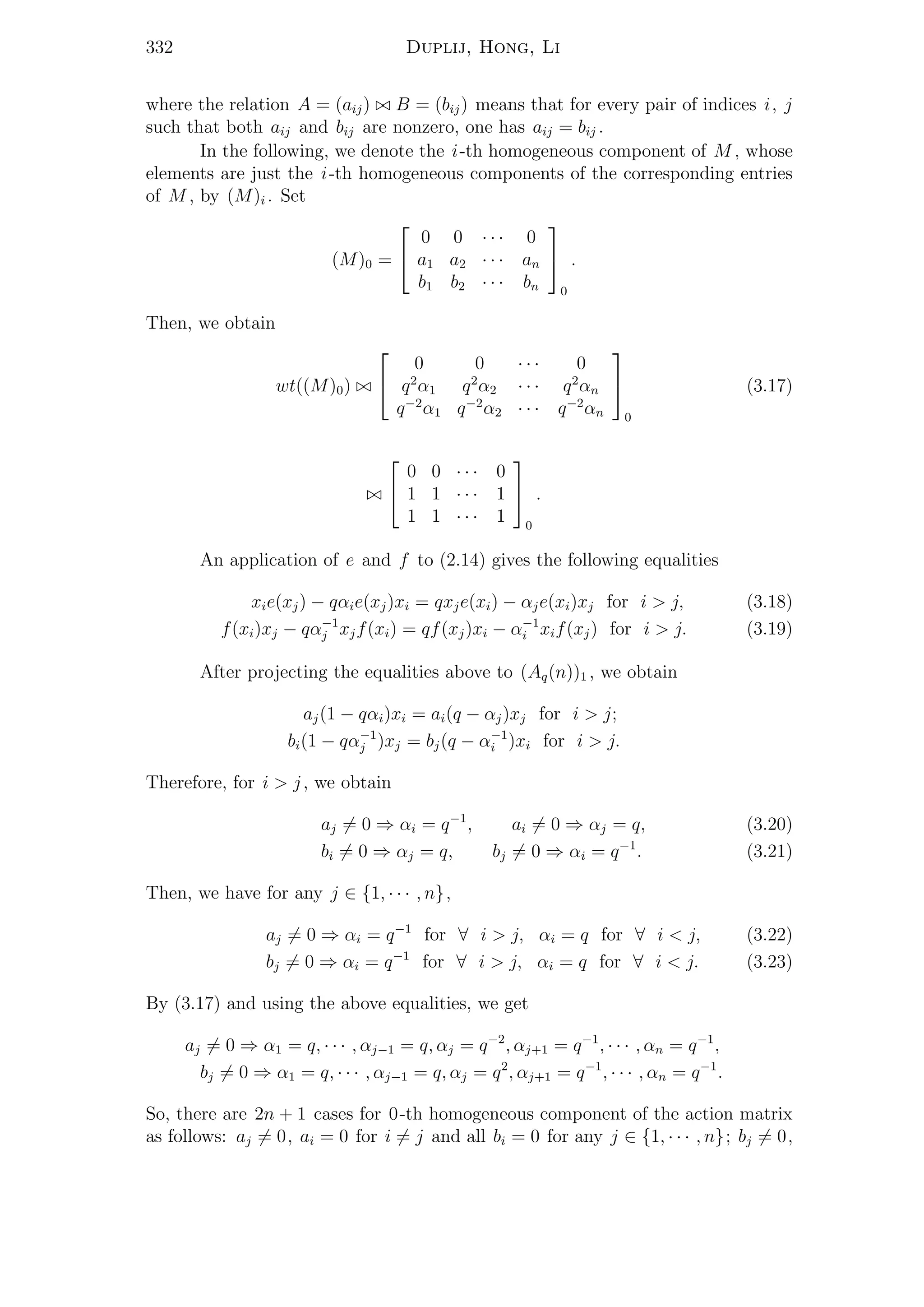
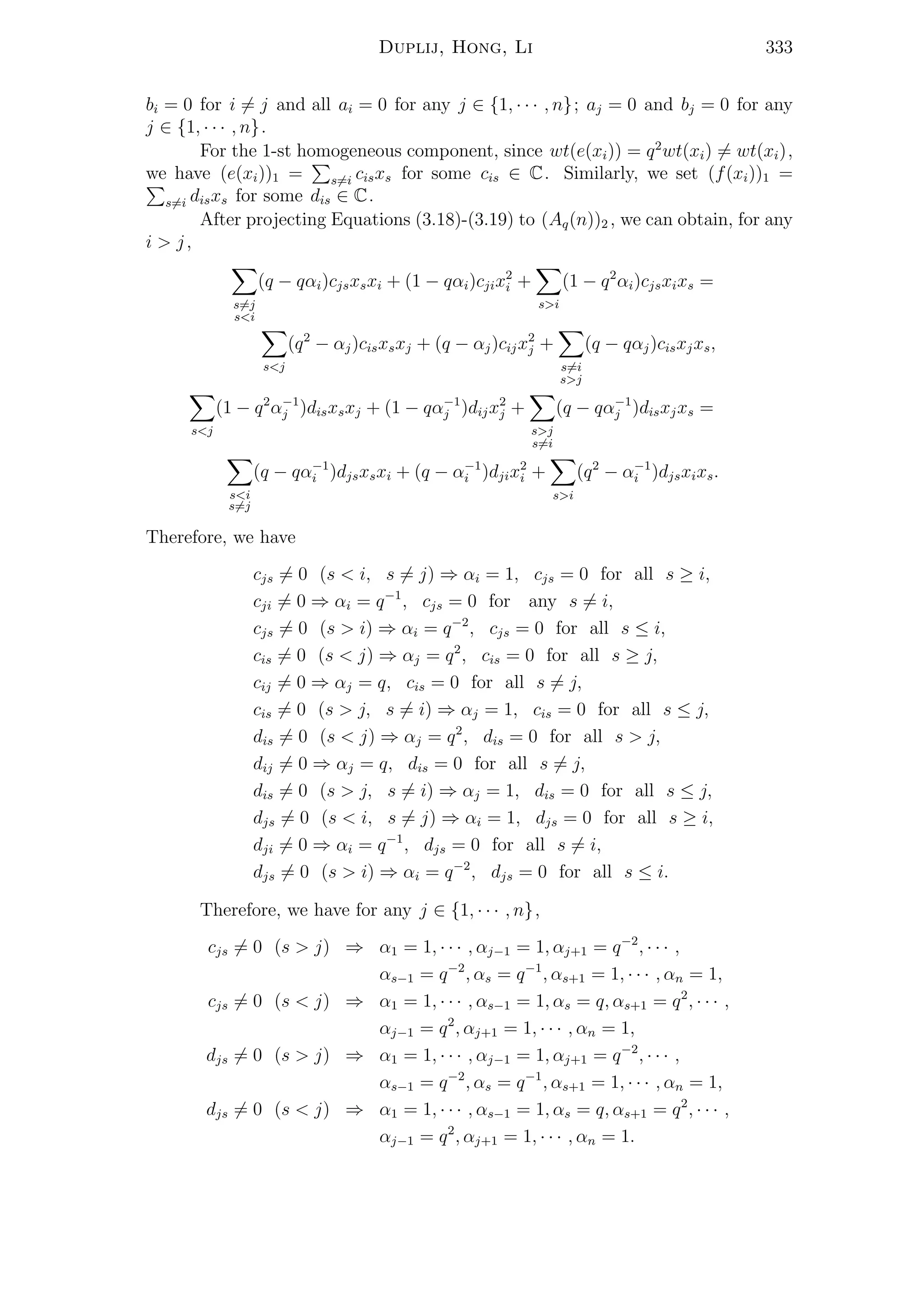
![334 Duplij, Hong, Li
Since wt((Mef )1) =
q2
α1 q2
α2 · · · q2
αn
q−2
α1 q−2
α2 · · · q−2
αn 1
, we obtain for any
j ∈ {1, · · · , n},
cjs = 0 (s > j) ⇒ α1 = 1, · · · , αj−1 = 1, αj = q−3
, αj+1 = q−2
, · · · ,
αs−1 = q−2
, αs = q−1
, αs+1 = 1, · · · , αn = 1,
cjs = 0 (s < j) ⇒ α1 = 1, · · · , αs−1 = 1, αs = q, αs+1 = q2
, · · · ,
αj−1 = q2
, αj = q−1
, αj+1 = 1, · · · , αn = 1,
djs = 0 (s > j) ⇒ α1 = 1, · · · , αj−1 = 1, αj = q, αj+1 = q−2
, · · · ,
αs−1 = q−2
, αs = q−1
, αs+1 = 1, · · · , αn = 1,
djs = 0 (s < j) ⇒ α1 = 1, · · · , αs−1 = 1, αs = q, αs+1 = q2
, · · · ,
αj−1 = q2
, αj = q3
, αj+1 = 1, · · · , αn = 1.
By the above discussion, we have only the following possibilities for the 1-st
homogeneous component: cij = 0 for some i = j, other cst equal to zero and all
dst = 0; dij = 0 for some i = j, other dst equal to zero and all cst = 0; cj+1,j = 0,
dj,j+1 = 0 for some j ∈ {1, · · · , n}.
Obviously, if both the 0-th homogeneous component and the 1-st homoge-
neous component of Mef are nonzero, there are no possibilities except when n = 3.
For n = 3, there are only two possibilities (a2 , d13 , b2 , c31 ∈ C{0}):
0 a2 0
0 0 0 0
,
0 0 0
d13 0 0 1
⇒ α1 = q, α2 = q−2
, α3 = q−1
, (3.24)
0 0 0
0 b2 0 0
,
0 0 c31
0 0 0 1
⇒ α1 = q, α2 = q2
, α3 = q−1
. (3.25)
Moreover, there are no possibilities when the 0-th homogeneous component
of Mef is 0 and the 1-st homogeneous component of Mef have only one nonzero
position. The reasons are the same as those in [8].
Therefore, by the above discussion, we can obtain the following theorem.
Theorem 3.1. Given a module algebra structure of Uq(sl(2)) on Aq(n). The 0-
th homogeneous component and 1-st homogeneous component of the action matrix
must be one of the following cases:
Case (3.24), Case (3.25) when n = 3,
0 0 · · · ai · · · 0
0 0 · · · 0 · · · 0 0
,
0 0 · · · 0
0 0 · · · 0 1
, ai = 0 for any i ∈ {1, · · · n},
0 0 · · · 0 · · · 0
0 0 · · · bi · · · 0 0
,
0 0 · · · 0
0 0 · · · 0 1
, bi = 0 for any i ∈ {1, · · · n},
0 0 · · · 0
0 0 · · · 0 0
,
0 0 · · · 0 cj+1,j · · · 0
0 0 · · · dj,j+1 0 · · · 0 1
, cj+1,j , dj,j+1 = 0 for
any j ∈ {1, · · · , n −1},
0 0 · · · 0
0 0 · · · 0 0
,
0 0 · · · 0
0 0 · · · 0 1
for any n ≥ 3.](https://image.slidesharecdn.com/duplij-hong-liuqslm1-modulealgebrastructuresonthecoordinatealgebraofaquantumvectorspace-151014142022-lva1-app6891/75/S-Duplij-Y-Hong-F-Li-Uq-sl-m-1-module-algebra-structures-on-the-coordinate-algebra-of-a-quantum-vector-space-8-2048.jpg)
![Duplij, Hong, Li 335
4. General structure of Uq(sl(m + 1))-module algebras on Aq(3)
In this section, we study the concrete actions of Uq(sl(2)) on Aq(3) and module
algebra structures of Uq(sl(3)) on Aq(3) which make some preparations on the
classification of module algebra structures of Uq(sl(m + 1)) on Aq(3) for m ≥ 2.
By Theorem 3.1, we only need to consider 11 possibilities
0 0 0
0 0 0 0
,
0 0 0
0 0 0 1
,
a1 0 0
0 0 0 0
,
0 0 0
0 0 0 1
,
0 0 0
0 0 b3 0
,
0 0 0
0 0 0 1
,
0 0 0
0 0 0 0
,
0 c21 0
d12 0 0 1
,
0 0 0
0 0 0 0
,
0 0 c32
0 d23 0 1
,
0 a2 0
0 0 0 0
,
0 0 0
0 0 0 1
,
0 a2 0
0 0 0 0
,
0 0 0
d13 0 0 1
,
0 0 0
0 b2 0 0
,
0 0 0
0 0 0 1
,
0 0 0
0 b2 0 0
,
0 0 c31
0 0 0 1
,
0 0 a3
0 0 0 0
,
0 0 0
0 0 0 1
,
0 0 0
b1 0 0 0
,
0 0 0
0 0 0 1
where ai = 0, bi = 0 for i = 1, 2, 3, and c21 , d12 ,
c32 , d23 , d13 , c31 are not zero.
For convenience, we denote these 11 kinds of cases in the above order by
(∗1), · · · , (∗11) respectively.
Lemma 4.1. For Case (∗1), all Uq(sl(2))-module algebra structures on Aq(3)
are as follows
k(x1) = ±x1, k(x2) = ±x2, k(x3) = ±x3, (4.26)
e(x1) = e(x2) = e(x3) = f(x1) = f(x2) = f(x3) = 0. (4.27)
Proof. The proof is similar to that in Theorem 4.2 in [8].
Lemma 4.2. For Case (∗2), all Uq(sl(2))-module algebra structures on Aq(3)
are
k(x1) = q−2
x1, k(x2) = q−1
x2, k(x3) = q−1
x3, (4.28)
e(x1) = a1, e(x2) = 0, e(x3) = 0, (4.29)
f(x1) = −qa−1
1 x2
1, (4.30)
f(x2) = −qa−1
1 x1x2 + ξ1x2x2
3 + ξ2x3
2 + ξ3x3
3, (4.31)
f(x3) = −qa−1
1 x1x3 + ξ4x2x2
3 + (1 + q + q2
)ξ2x2
2x3 − q−1
ξ1x3
3, (4.32)
where a1 ∈ C{0}, and ξ1 , ξ2 , ξ3 , ξ4 ∈ C.
Proof. Since wt(Mef )
1 q q
q−4
q−3
q−3 and α1 = q−2
, α2 = q−1
, α3 =
q−1
, we must have e(x1) = a1 , e(x2) = 0, e(x3) = 0. For the same reason, f(x1),
f(x2), f(x3) must be of the following forms:
f(x1) = u1x2
1 +u2x1x2
2 +u3x1x2
3 +u4x1x2x3 +u5x2x3
3 +u6x2
2x2
3 +u7x3
2x3 +u8x4
2 +u9x4
3,
f(x2) = v1x1x2 + v2x1x3 + v3x2x2
3 + v4x2
2x3 + v5x3
2 + v6x3
3,](https://image.slidesharecdn.com/duplij-hong-liuqslm1-modulealgebrastructuresonthecoordinatealgebraofaquantumvectorspace-151014142022-lva1-app6891/75/S-Duplij-Y-Hong-F-Li-Uq-sl-m-1-module-algebra-structures-on-the-coordinate-algebra-of-a-quantum-vector-space-9-2048.jpg)
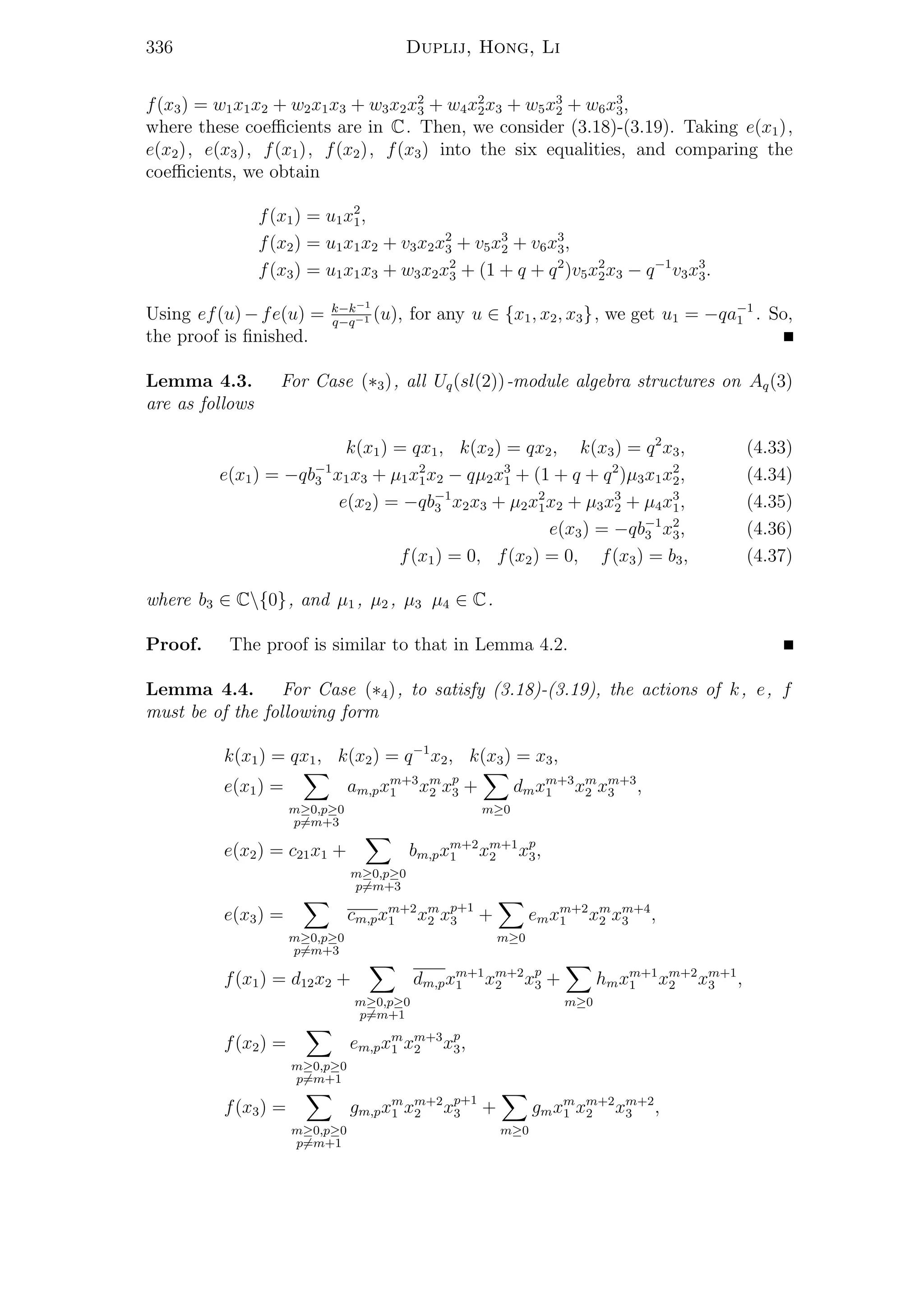
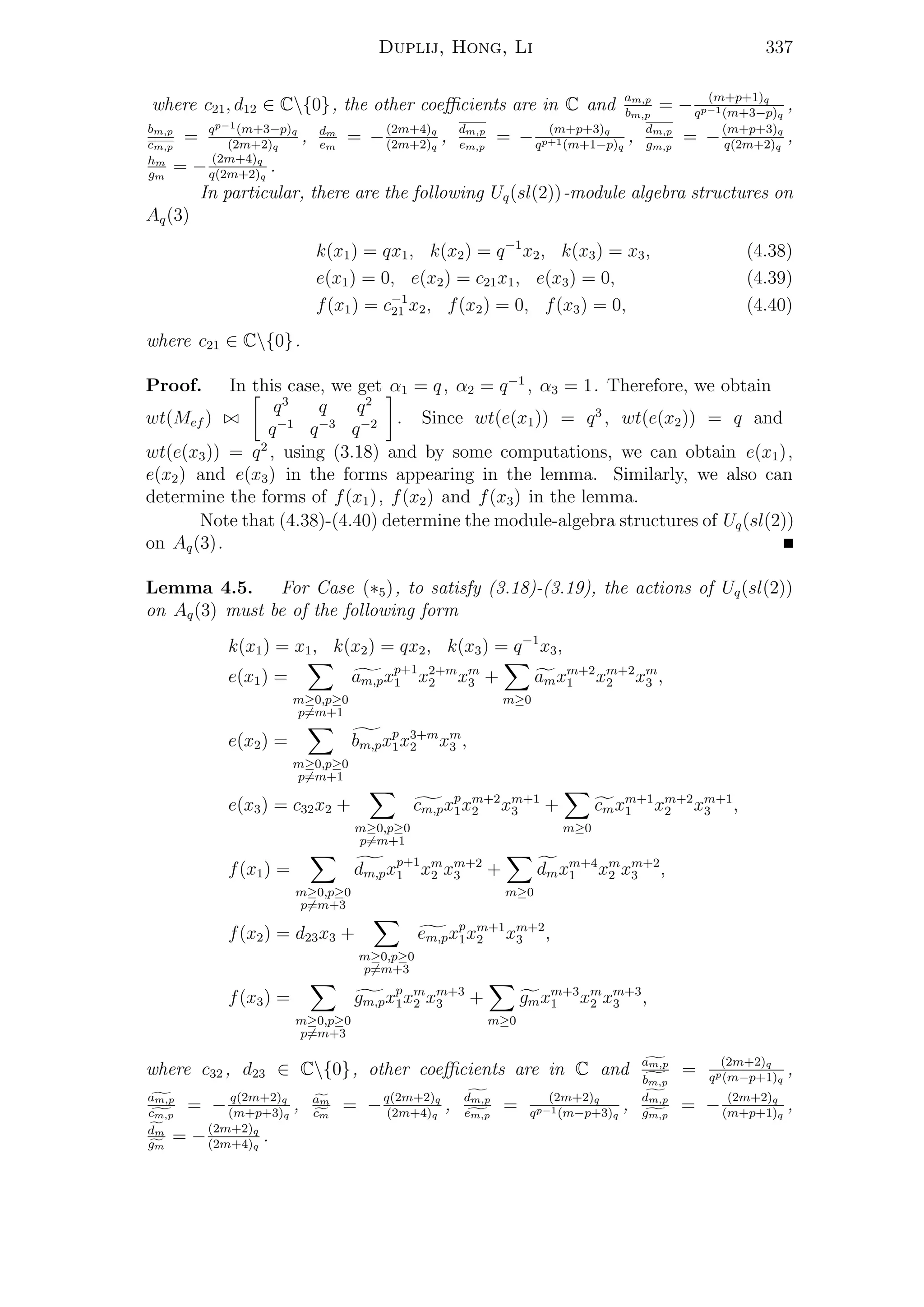
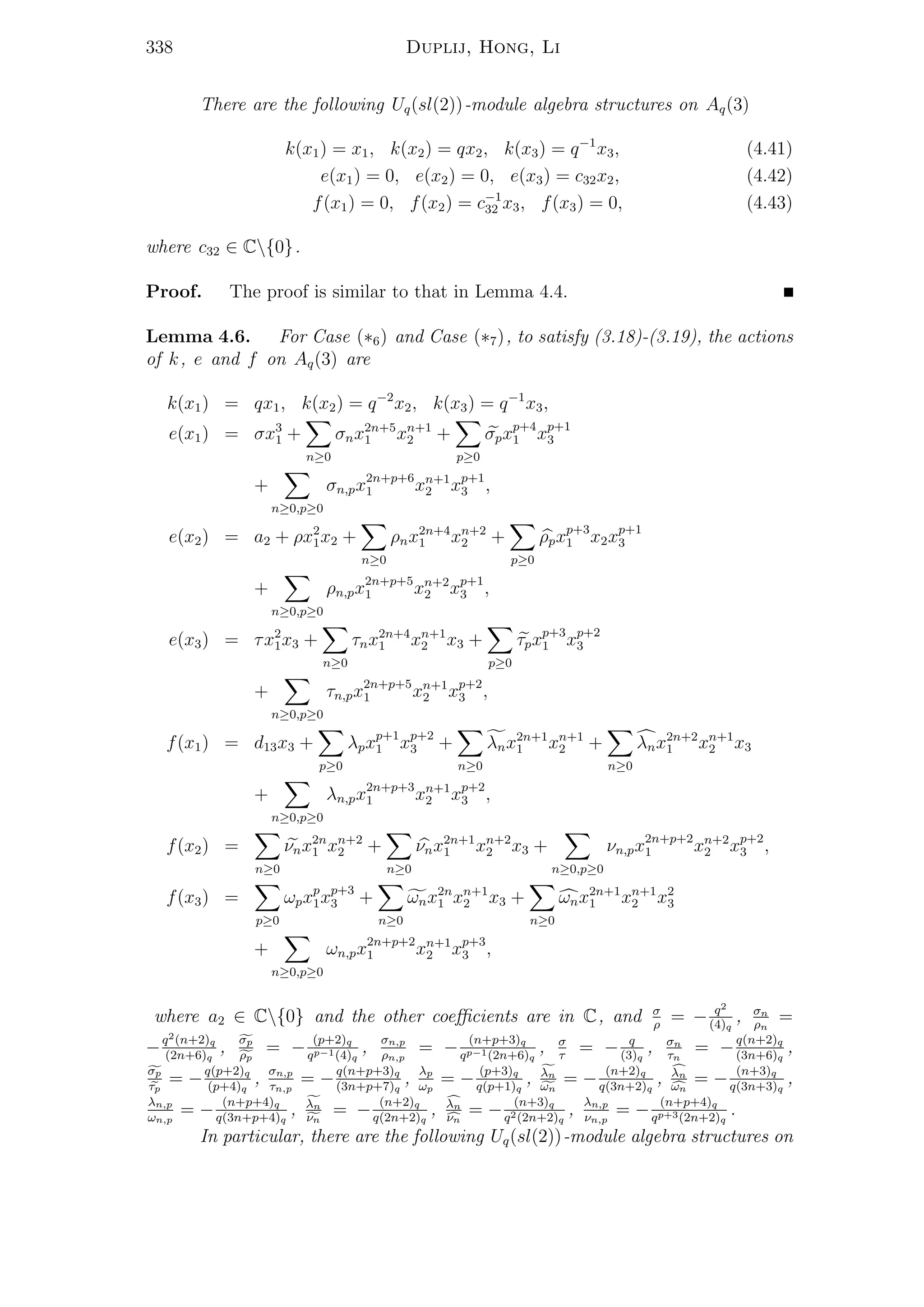

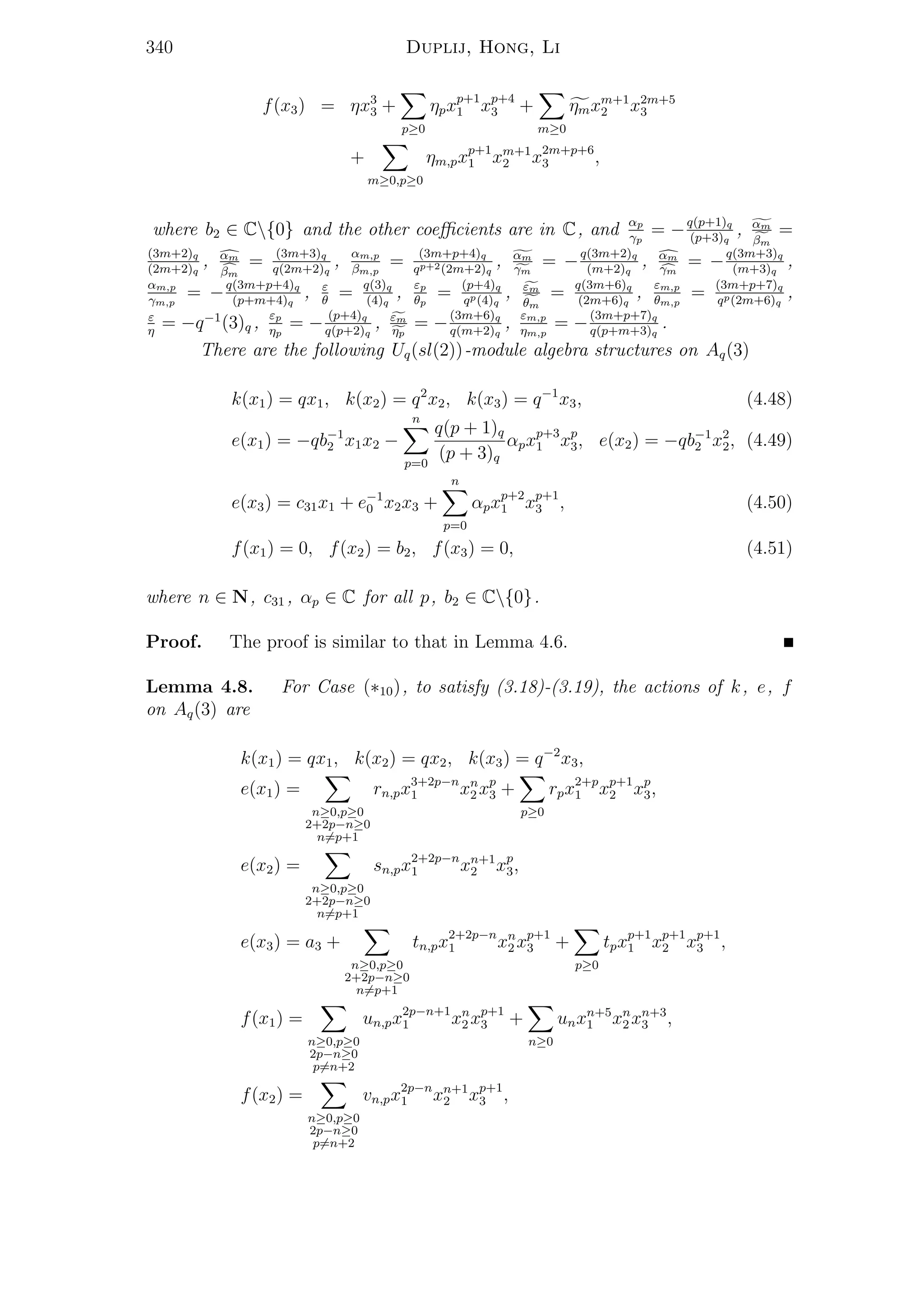
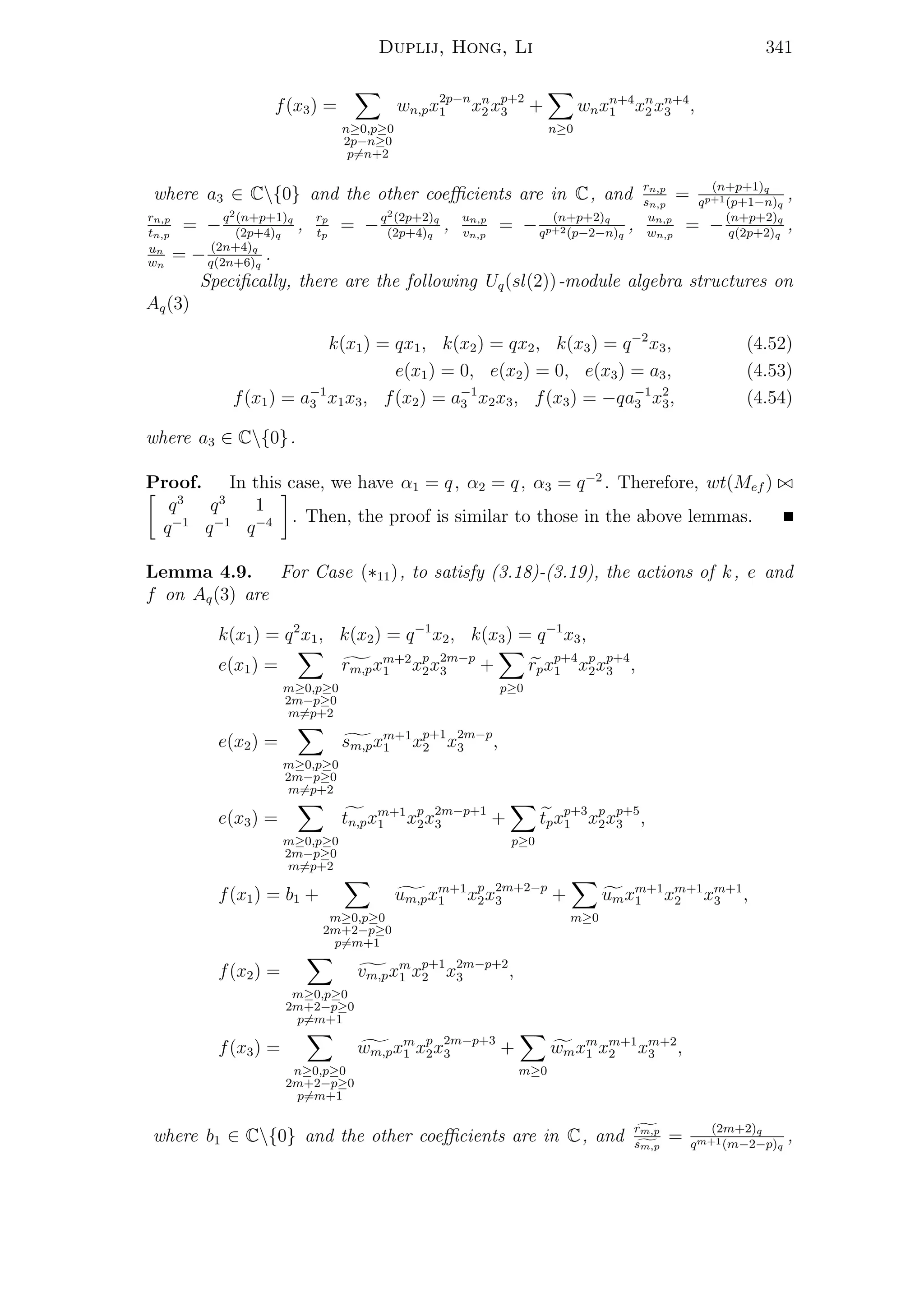
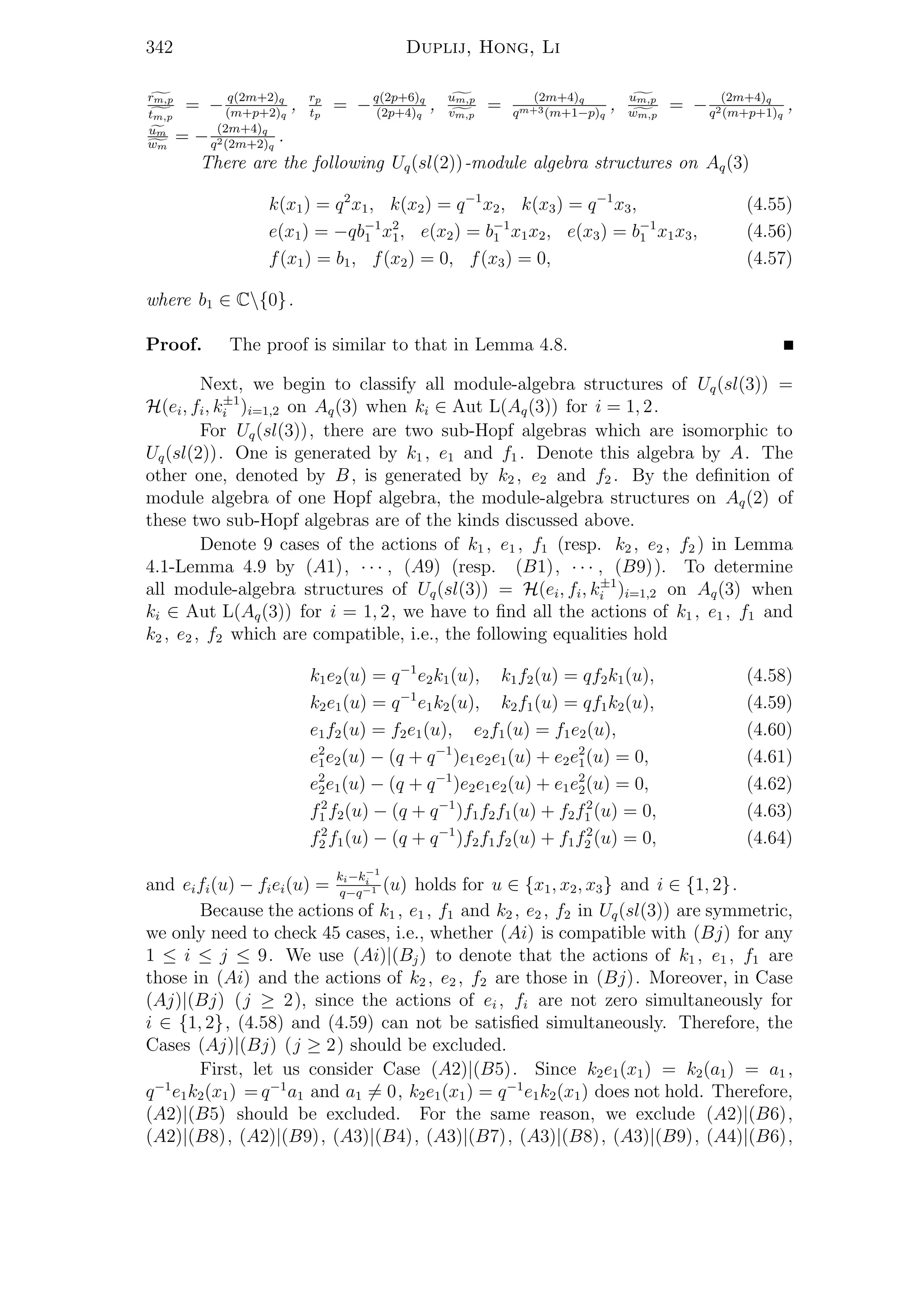

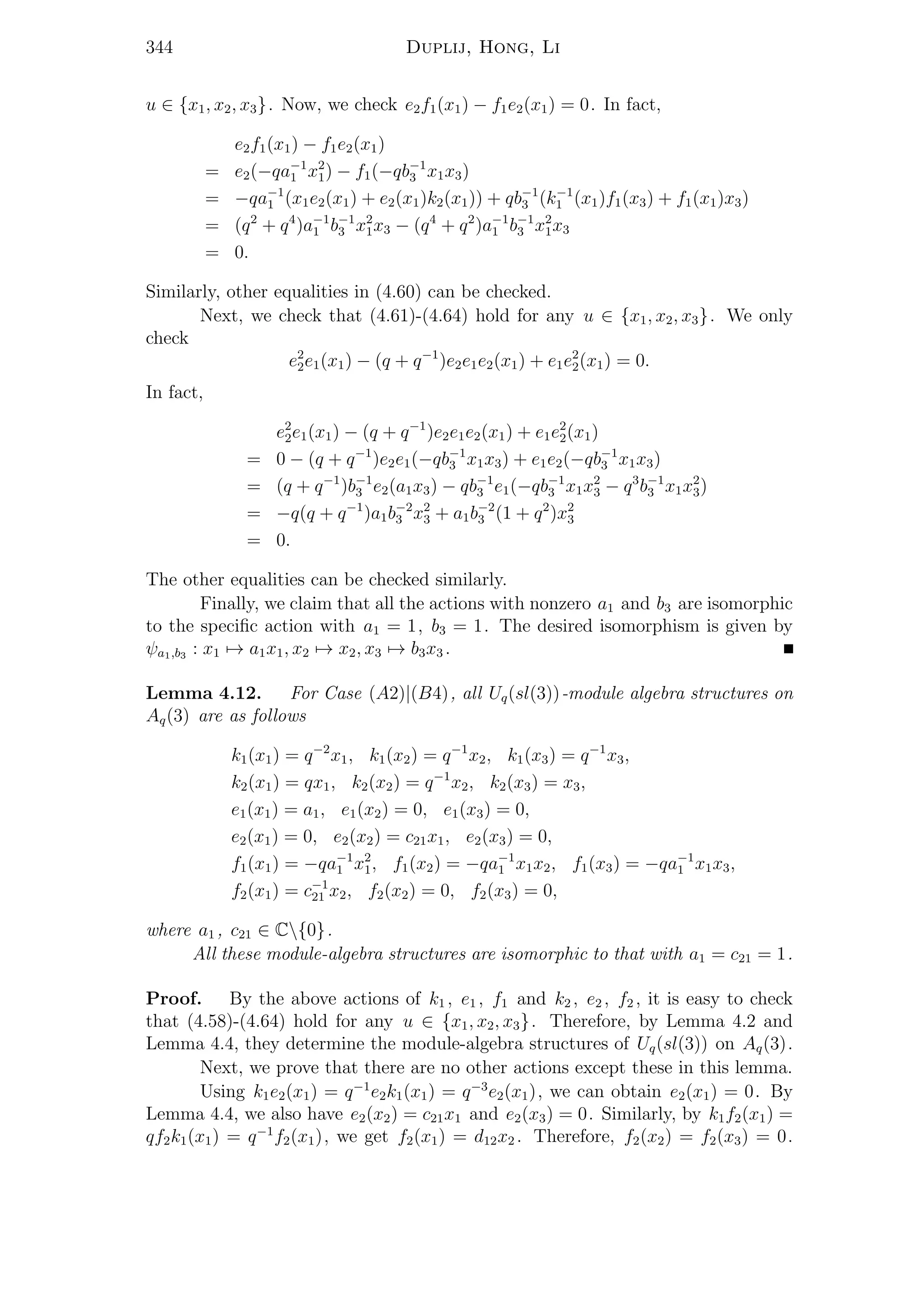

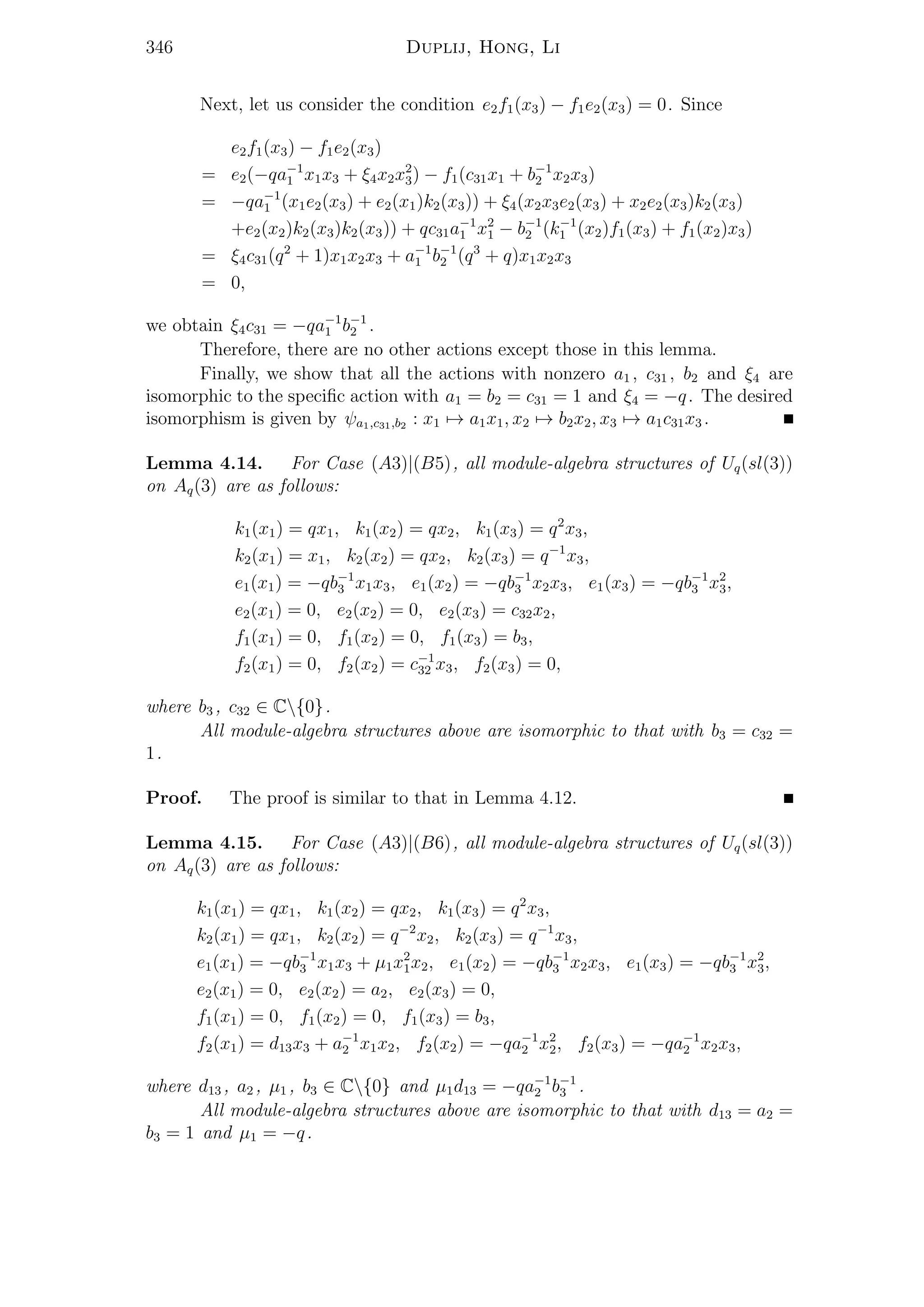

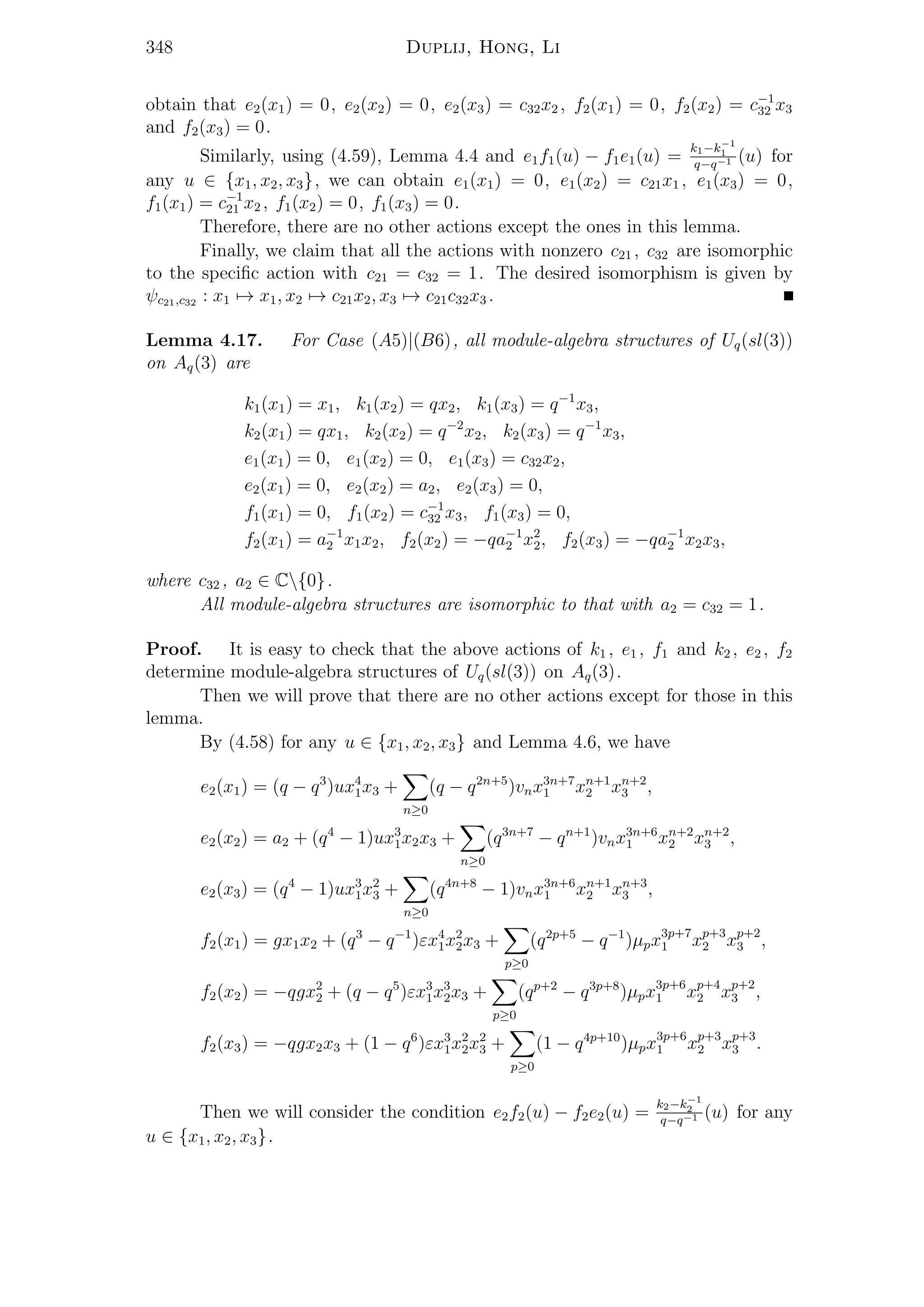
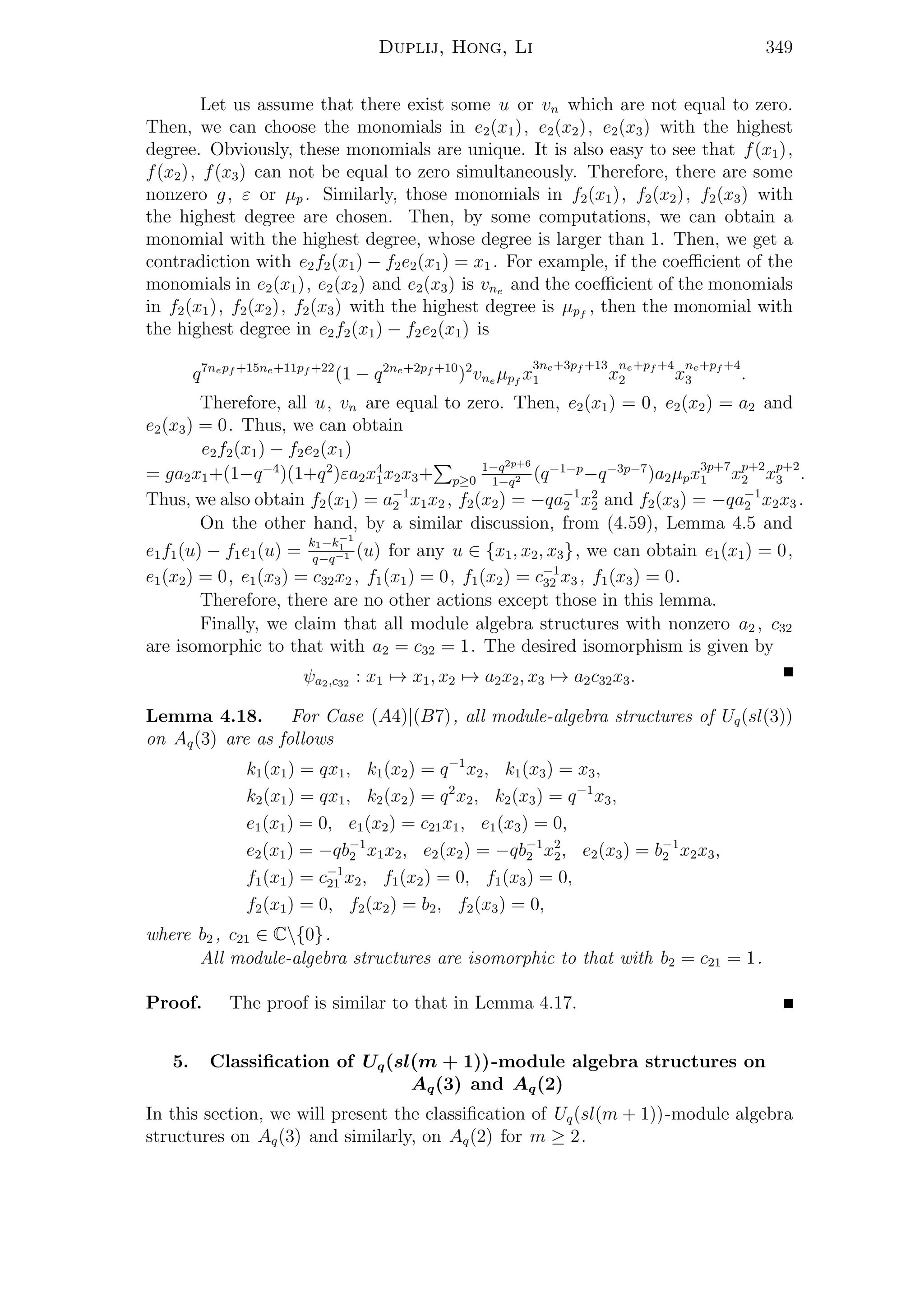
![350 Duplij, Hong, Li
The associated classical limit actions of sl3 (which here is the Lie algebra
generated by h1 , h2 , e1 , e2 , f1 , f2 with the relations [e1, f1] = h1 , [e2, f2] = h2 ,
[e1, f2] = [e2, f1] = 0, [h1, e1] = 2e1 , [h1, e2] = −e2 , [h2, e2] = 2e2 , [h2, e1] =
−e1 , [h1, f1] = −2f1 , [h1, f2] = f2 , [h2, f2] = −2f2 , [h2, f1] = f1 , [h1, h2] =
0) on C[x1, x2, x3] by differentiations are derived from the quantum actions via
substituting k1 = qh1
, k2 = qh2
with a subsequent formal passage to the limit as
q → 1.
Since the actions of k1 , e1 , f1 and k2 , e2 , f2 in Uq(sl(3)) are symmetric,
by Lemma 4.10-Lemma 4.18 and the discussion above, we obtain the following
theorem.
Theorem 5.1. Uq(sl(3)) = H(ei, fi, k±1
i )i=1,2 -module algebra structures up to
isomorphisms on Aq(3) when ki ∈ Aut L(Aq(3)) for i = 1, 2 and their classical
limits, i.e., Lie algebra sl3 -actions by differentiations on C[x1, x2, x3] are as fol-
lows:
Uq(sl(3))-module Classical limit
algebra structures sl3-actions on C[x1, x2, x3]
ki(xs) = ±xs, kj(xs) = ±xs, hi(xs) = 0, hj(xs) = 0,
ei(xs) = 0, ej(xs) = 0, ei(xs) = 0, ej(xs) = 0,
fi(xs) = 0, fj(xs) = 0, fi(xs) = 0, fj(xs) = 0,
s ∈ {1, 2, 3} s ∈ {1, 2, 3}
ki(x1) = q−2
x1, ki(x2) = q−1
x2, hi(x1) = −2x1, hi(x2) = −x2,
ki(x3) = q−1
x3, kj(x1) = qx1, hi(x3) = −x3, hj(x1) = x1,
kj(x2) = qx2, kj(x3) = q2
x3, hj(x2) = x2, hj(x3) = 2x3,
ei(x1) = 1, ei(x2) = 0, ei(x3) = 0, ei(x1) = 1, ei(x2) = 0, ei(x3) = 0,
ej(x1) = −qx1x3, ej(x2) = −qx2x3, ej(x1) = −x1x3, ej(x2) = −x2x3,
ej(x3) = −qx2
3, fi(x1) = −qx2
1, ej(x3) = −x2
3, fi(x1) = −x2
1,
fi(x2) = −qx1x2, fi(x3) = −qx1x3, fi(x2) = −x1x2, fi(x3) = −x1x3,
fj(x1) = 0, fj(x2) = 0, fj(x3) = 1 fj(x1) = 0, fj(x2) = 0, fj(x3) = 1
ki(x1) = q−2
x1, ki(x2) = q−1
x2, hi(x1) = −2x1, hi(x2) = −x2,
ki(x3) = q−1
x3, kj(x1) = qx1, hi(x3) = −x3, hj(x1) = x1,
kj(x2) = q−1
x2, kj(x3) = x3, hj(x2) = −x2, hj(x3) = 0,
ei(x1) = 1, ei(x2) = 0, ei(x3) = 0, ei(x1) = 1, ei(x2) = 0, ei(x3) = 0,
ej(x1) = 0, ej(x2) = x1, ej(x3) = 0, ej(x1) = 0, ej(x2) = x1, ej(x3) = 0,
fi(x1) = −qx2
1, fi(x2) = −qx1x2, fi(x1) = −x2
1, fi(x2) = −x1x2,
fi(x3) = −qx1x3, fi(x3) = −x1x3,
fj(x1) = x2, fj(x2) = 0, fj(x3) = 0 fj(x1) = x2, fj(x2) = 0, fj(x3) = 0](https://image.slidesharecdn.com/duplij-hong-liuqslm1-modulealgebrastructuresonthecoordinatealgebraofaquantumvectorspace-151014142022-lva1-app6891/75/S-Duplij-Y-Hong-F-Li-Uq-sl-m-1-module-algebra-structures-on-the-coordinate-algebra-of-a-quantum-vector-space-24-2048.jpg)

![352 Duplij, Hong, Li
for any i = 1, j = 2 or i = 2, j = 1. Moreover, there are no isomorphisms be-
tween these nine kinds of module-algebra structures.
Remark 5.2. Case (5) when i = 1, j = 2 in Theorem 5.1 is the case discussed
in [15] when n = 3.
Let us denote the actions of Uq(sl(2)) on Aq(3) in (A1), those in (A2) and
(B3) in Lemma 4.11, those in (B4) in Lemma 4.12, those in (B5) in Lemma 4.14,
those in (B6) in Lemma 4.17 and those in (B7) in Lemma 4.18 by 1, 2, 3, 4,
5, 6, 7 respectively. In addition, denote the actions of Uq(sl(2)) on Aq(3) in
(A2) and (B7) in Lemma 4.13, those in (A3) and (B6) in Lemma 4.15 by 2 , 7 ,
3 , 6 respectively. If s and t are compatible, in other words, they determine
a Uq(sl(3))-module algebra structure on Aq(3), we use an edge connecting s and
t, since k1 , e1 , f1 and k2 , e2 , f2 are symmetric in Uq(sl(3)). Then, we can use
the following diagrams to denote all actions of Uq(sl(3)) = H(ei, fi, ki, k−1
i )i=1,2 on
Aq(3) when ki ∈ Aut L(Aq(3)) for i = 1, 2:
1 1 , 7 2 , 3 6 , (5.65)
2 3
7 4 5 6
. (5.66)
Here, every two adjacent vertices corresponds to two classes of the module-algebra
structures of Uq(sl(3)) on Aq(3). For example, 2 3 corresponds to the
following two kinds of module-algebra structures of Uq(sl(3)) on Aq(3): one has
actions of k1 , e1 , f1 that are of type 2 and actions of k2 , e2 , f2 that are of type
3; the other has actions of k1 , e1 , f1 that are of type 3 and actions of k2 , e2 ,
f2 that are of type 2.
Next, we will begin to study the module-algebra structures of Uq(sl(m +
1)) = H(ei, fi, k±1
i )1≤i≤m on Aq(3), when ki ∈ Aut L(Aq(3)) for i = 1, · · · , m and
m ≥ 3. The corresponding Dynkin diagram of sl(m + 1) with m vertices is as
follows:
◦ ◦ · · · ◦ ◦ .
In Uq(sl(m + 1)), every vertex corresponds to one Hopf subalgebra isomorphic to
Uq(sl(2)) and two adjacent vertices correspond to one Hopf subalgebra isomorphic
to Uq(sl(3)). Therefore, for studying the module-algebra structures of Uq(sl(m +
1)) on Aq(3), we have to endow every vertex in the Dynkin diagram of sl(m + 1)
an action of Uq(sl(2)) on Aq(3). Moreover, there are some rules which we should
obey:
1. Since every pair of adjacent vertices in the Dynkin diagram corresponds to
one Hopf subalgebra isomorphic to Uq(sl(3)), by Theorem 5.1, the action of
Uq(sl(2)) on Aq(3) on every vertex should be one of the following 11 kinds
of possibilities: 1, 2, 3, 4, 5, 6, 7, 2 , 7 , 3 , 6 . Moreover,
every pair of adjacent vertices should be of the types in (5.65) and (5.66).](https://image.slidesharecdn.com/duplij-hong-liuqslm1-modulealgebrastructuresonthecoordinatealgebraofaquantumvectorspace-151014142022-lva1-app6891/75/S-Duplij-Y-Hong-F-Li-Uq-sl-m-1-module-algebra-structures-on-the-coordinate-algebra-of-a-quantum-vector-space-26-2048.jpg)

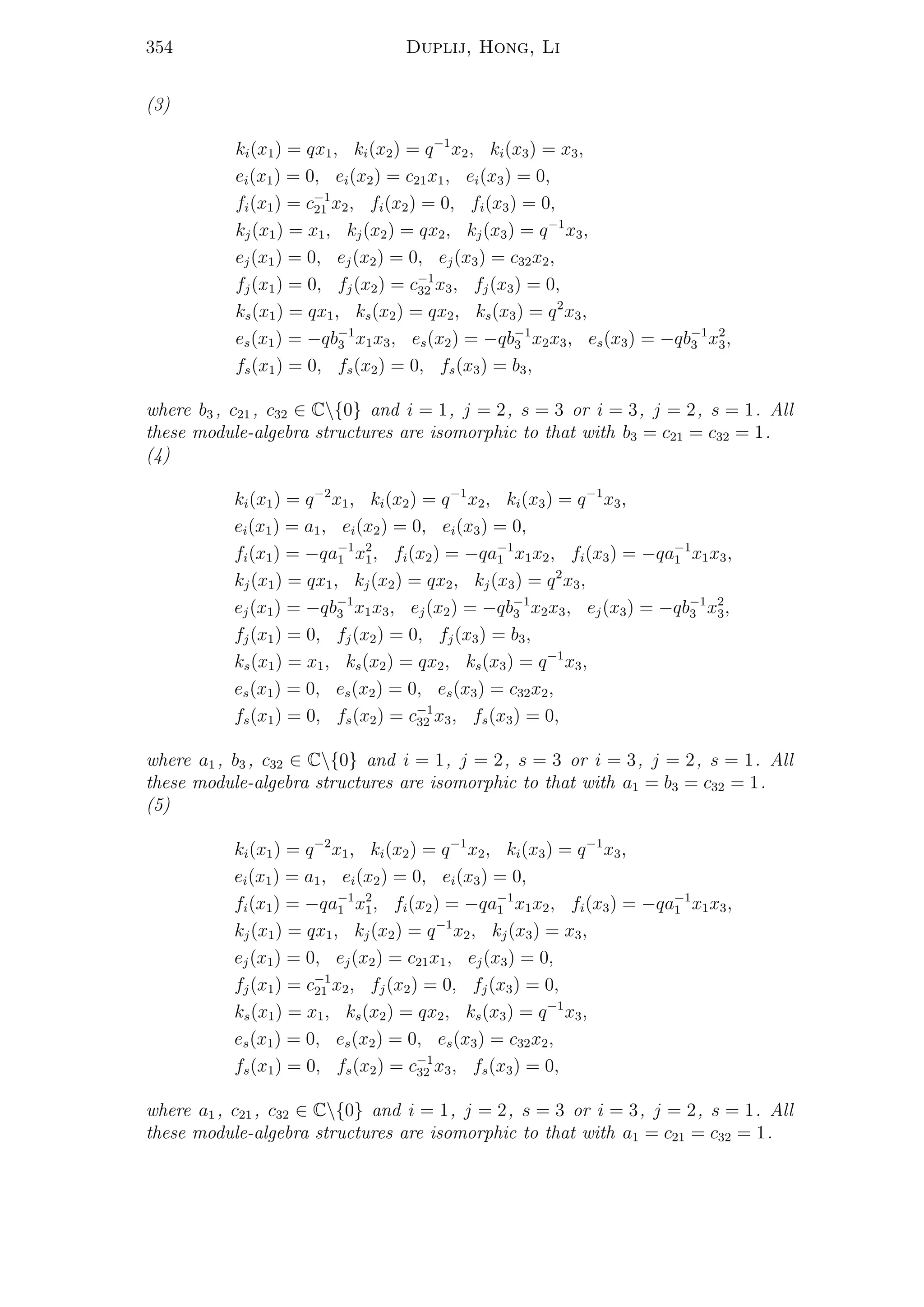
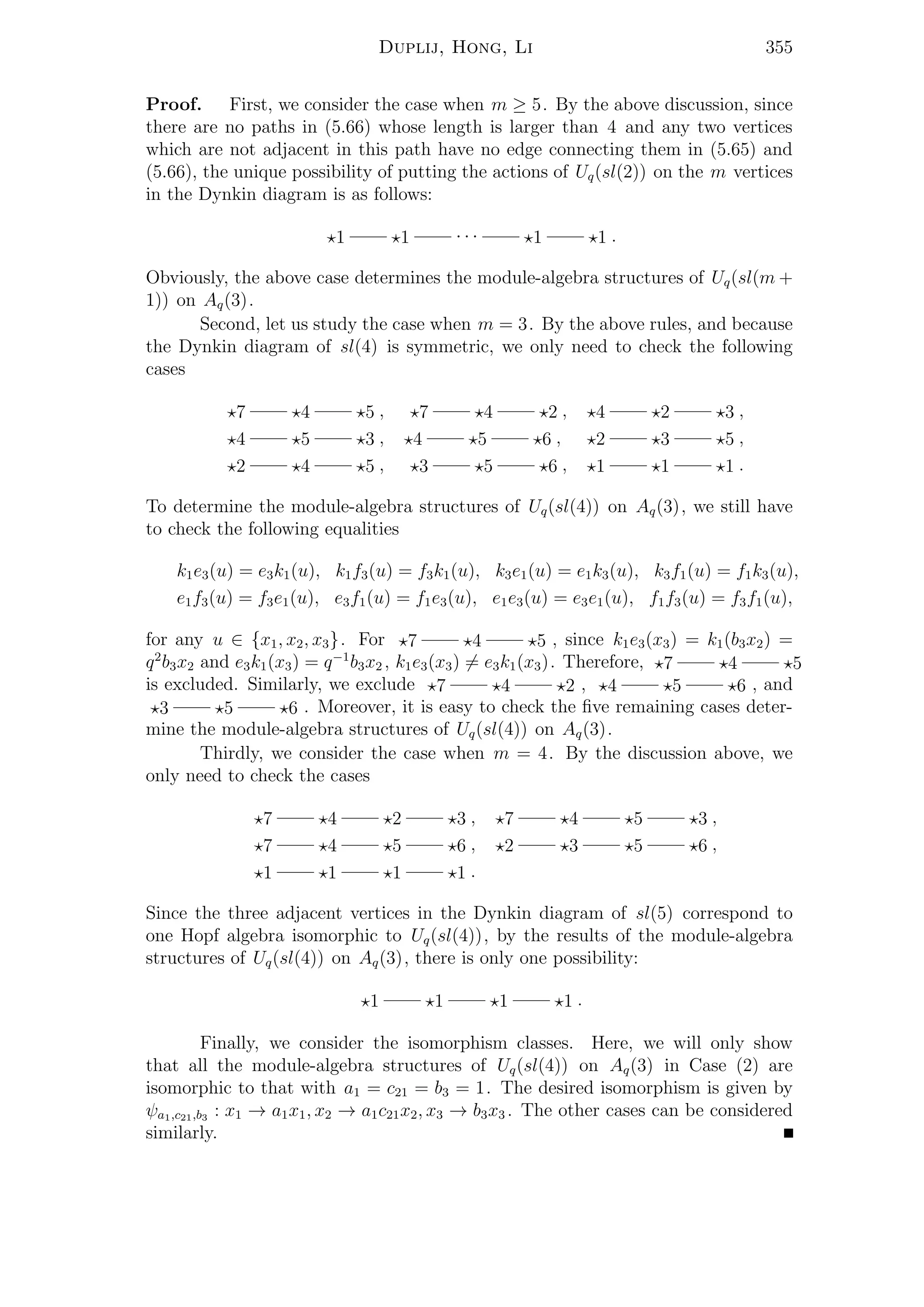
![356 Duplij, Hong, Li
Remark 5.4. By Theorem 5.3, the classical limits of the above actions, i.e. the
Lie algebra slm+1 -actions by differentiations on C[x1, x2, x3] can also be obtained,
as before.
Finally, we present a classification of Uq(sl(m + 1))-module algebra struc-
tures on Aq(2).
Since all module-algebra structures of Uq(sl(2)) on Aq(2) are presented in
[8], using the same method as above and by some computations, we can obtain
the following theorem.
Theorem 5.5. Uq(sl(3))-module algebra structures on Aq(2) up to isomor-
phisms and their classical limits are as follows:
Uq(sl(3))-module Classical limit
algebra structures sl3-actions on C[x1, x2]
ki(xs) = ±xs, kj(xs) = ±xs, hi(xs) = 0, hj(xs) = 0,
ei(xs) = 0, ej(xs) = 0, ei(xs) = 0, ej(xs) = 0,
fi(xs) = 0, fj(xs) = 0, fi(xs) = 0, fj(xs) = 0,
s ∈ {1, 2} s ∈ {1, 2}
ki(x1) = q−2
x1, ki(x2) = q−1
x2, hi(x1) = −2x1, hi(x2) = −x2,
kj(x1) = qx1, kj(x2) = q−1
x2, hj(x1) = x1, hj(x2) = −x2,
ei(x1) = 1, ei(x2) = 0, ei(x1) = 1, ei(x2) = 0,
ej(x1) = 0, ej(x2) = x1, ej(x1) = 0, ej(x2) = x1,
fi(x1) = −qx2
1, fi(x2) = −qx1x2, fi(x1) = −x2
, fi(x2) = −x1x2,
fj(x1) = x2, fj(x2) = 0 fj(x1) = x2, fj(x2) = 0
ki(x1) = qx1, ki(x2) = q2
x2, hi(x1) = x1, hi(x2) = 2x2,
kj(x1) = qx1, kj(x2) = q−1
x2, hj(x1) = x1, hj(x2) = −x2,
ei(x1) = −qx1x2, ei(x2) = −qx2
2, ei(x1) = −x1x2, ei(x2) = −x2
2,
ej(x1) = 0, ej(x2) = x1, ej(x1) = 0, ej(x2) = x1,
fi(x1) = 0, fi(x2) = 1, fi(x1) = 0, fi(x2) = 1,
fj(x1) = x2, fj(x2) = 0 fj(x1) = x2, fj(x2) = 0
ki(x1) = q−2
x1, ki(x2) = q−1
x2, hi(x1) = −2x1, hi(x2) = −x2,
kj(x1) = qx1, kj(x2) = q2
x2, hj(x1) = x1, hj(x2) = 2x2,
ei(x1) = 1, ei(x2) = 0, ei(x1) = 1, ei(x2) = 0,
ej(x1) = −qx1x2, ej(x2) = −qx2
2, ej(x1) = −x1x2, ej(x2) = −x2
2,
fi(x1) = −qx2
1, fi(x2) = −qx1x2, fi(x1) = −x2
1, fi(x2) = −x1x2,
fj(x1) = 0, fj(x2) = 1 fj(x1) = 0, fj(x2) = 1
for any i = 1, j = 2 or i = 2, j = 1. Note that there are no isomorphisms
between these four kinds of module-algebra structures.
Moreover, for any m ≥ 3, all module-algebra structures of Uq(sl(m + 1))
on Aq(2) are as follows:
ki(x1) = ±x1, ki(x2) = ±x2,
ei(x1) = ei(x2) = fi(x1) = fi(x2) = 0,
for any i ∈ {1, · · · , m}.](https://image.slidesharecdn.com/duplij-hong-liuqslm1-modulealgebrastructuresonthecoordinatealgebraofaquantumvectorspace-151014142022-lva1-app6891/75/S-Duplij-Y-Hong-F-Li-Uq-sl-m-1-module-algebra-structures-on-the-coordinate-algebra-of-a-quantum-vector-space-30-2048.jpg)
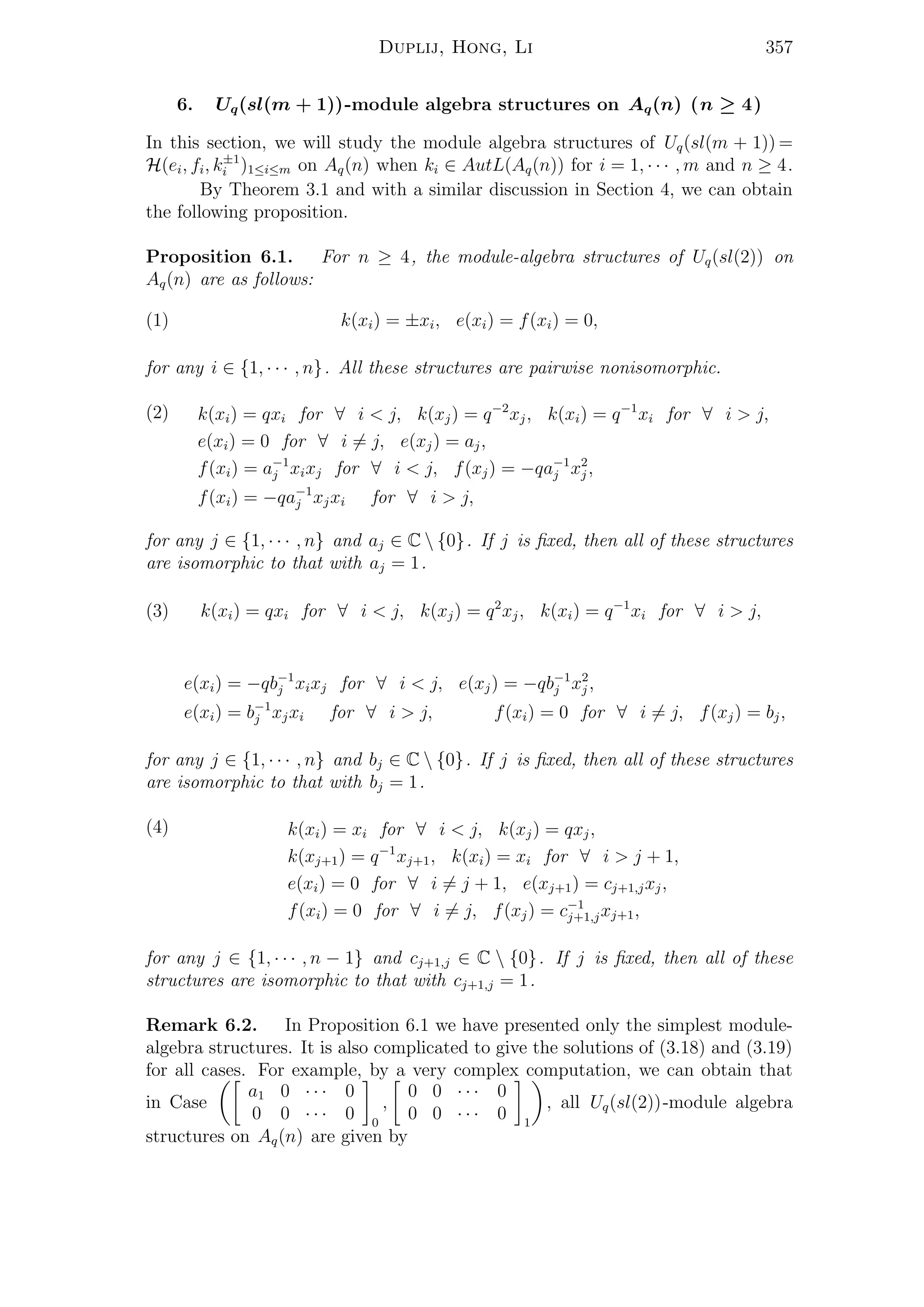
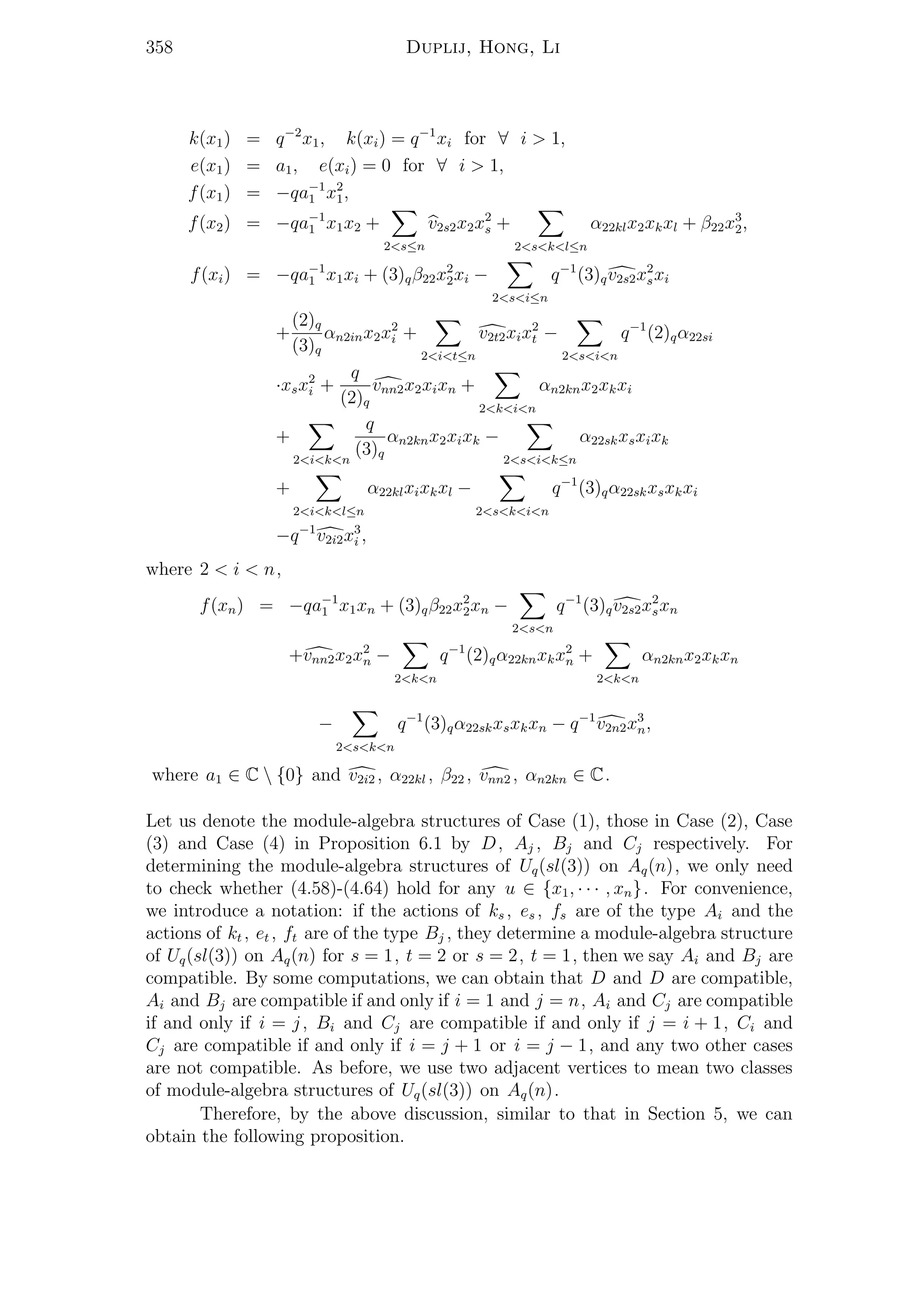
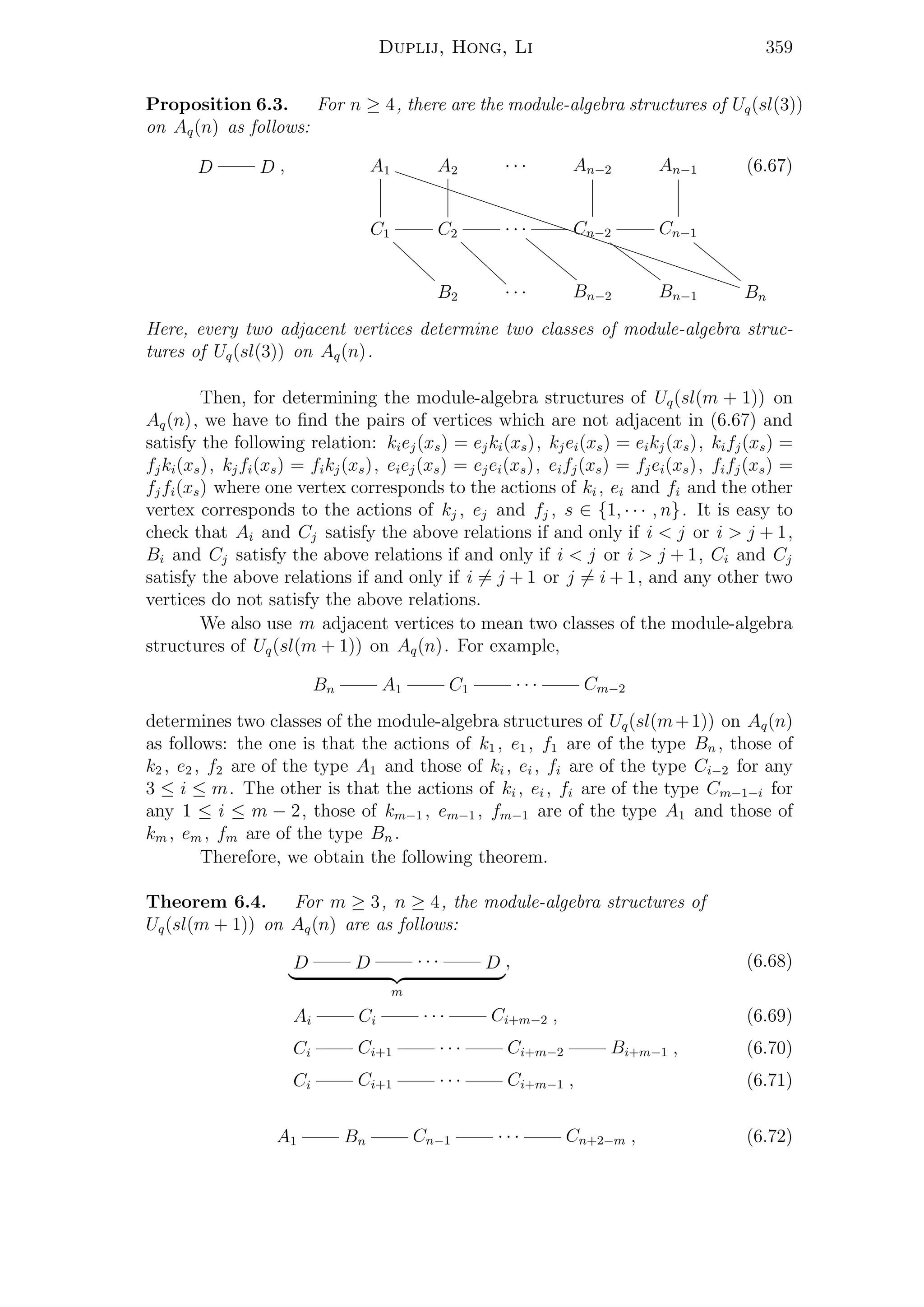
![360 Duplij, Hong, Li
where n + 2 − m > 1,
Bn A1 C1 · · · Cm−2 , (6.73)
where m − 2 < n − 1.
Here, every such diagram corresponds to two classes of the module-algebra
structures of Uq(sl(m + 1)) on Aq(n).
Remark 6.5. When m = n − 1 and the indexes of the vertices of the Dynkin
diagram are given 1, · · · , n − 1 from the left to the right, the actions correspond
to (6.71), i.e., C1 C2 · · · Cn−1 is the case discussed in [15]. In
addition, we are sure that when m ≥ n + 1, all the module-algebra structures of
Uq(sl(m + 1)) on Aq(n) are of the type in (6.68), since there are no paths whose
length is larger than n + 1 and any two vertices which are not adjacent in this
path have no edge connecting them in (6.67). The detailed proof may be similar
to that in Section 5. Moreover, the module-algebra structures of the quantum
enveloping algebras corresponding to the other semisimple Lie algebras on Aq(n)
can be considered in the same way.
Acknowledgments. The first author (S.D.) is grateful to L. Carbone, J. Cuntz,
P. Etingof, and E. Karolinsky for discussions, and to the Alexander von Humboldt
Foundation for funding his research stay at the University of M¨unster in 2014,
where this work was finalized.
References
[1] Alev, J., and M. Chamarie, D´erivations et automorphismes de quelques
alg`ebres quantiques, Comm. Algebra 20 (1992), 1787–1802.
[2] Artamonov, V. A., Actions of pointlike Hopf algebras on quantum polynomials,
Russian Math. Surveys 55 (2000), 1137–1138.
[3] —, Actions of Hopf algebras on quantum polynomials, Lect. Notes Pure Appl.
Math. 224 (2002), 11–20.
[4] Castellani, L., and J. Wess, “Quantum groups and their applications in
physics,” IOS Press, Amsterdam, 1996.
[5] Chan, K., C. Walton, Y. Wang, and J. J. Zhang, Hopf actions on filtered
regular algebras, J. Algebra 397 (2014), 68–90.
[6] Drabant, B., A. Van Daele, and Y. Zhang, Actions of multiplier Hopf algebras,
Comm. Algebra 27 (1999), 4117–4172.
[7] Drinfeld, V. G., “Quantum groups,” In: Proc. Int. Cong. Math. (Berkeley,
1986), Amer. Math. Soc., Providence, R. I., 1987, 798–820.
[8] Duplij, S., and S. Sinel’shchikov, Classification of Uq (sl2)-module algebra
structures on the quantum plane, J. Math. Physics, Analysis, Geometry 6
(2010), 406–430.](https://image.slidesharecdn.com/duplij-hong-liuqslm1-modulealgebrastructuresonthecoordinatealgebraofaquantumvectorspace-151014142022-lva1-app6891/75/S-Duplij-Y-Hong-F-Li-Uq-sl-m-1-module-algebra-structures-on-the-coordinate-algebra-of-a-quantum-vector-space-34-2048.jpg)
![Duplij, Hong, Li 361
[9] —, On Uq (sl2)-actions on the quantum plane, Acta Polytechnica 50 (2010),
25–29.
[10] Etingof, P., and C. Walton, Semisimple Hopf actions on commutative do-
mains, Adv. Math. 251 (2014), 47–61.
[11] —, Pointed Hopf actions on fields, I, arXiv:1403.4673v2.
[12] Faddeev, L. D., N. Yu. Reshetikhin, and L. A. Takhtadzhyan, Quantization of
Lie groups and Lie algebras, Leningrad Math J. 1 (1990), 193–225 (Russian
original in Algebra and Analysis, 1989; see also LOMI preprint E 14-87).
[13] Goodearl, K. R., and E. S. Letzter, Quantum n-spaces as a quotient of
classical n-space, Trans. Amer. Math. Soc. 352 (2000), 5855–5876.
[14] Heine, E.,
”
Handbuch der Kugelfunktionan“, Reimer, Berlin, 1878.
[15] Hu, N. H., Quantum divided power algebra, q-derivatives, and some new
quantum groups, J. Algebra 232(2000), 507–540.
[16] Jimbo, M., A q-difference analogue of U(g) and the Yang-Baxter equation,
Lett. Math. Phys. 10 (1985), 63–69.
[17] Kac, V., and P. Cheung, “Quantum calculus,” Springer, New York, 2002.
[18] Kassel, C., “Quantum Groups,” Springer, New York, 1995.
[19] Klimyk, A., and K. Schm¨udgen, “Quantum Groups and their Representa-
tions,” Springer-Verlag, Berlin, 1997.
[20] Manin, Yu. I., “Topics in Noncommutative Differential Geometry,” Princeton
University Press, Princeton, 1991.
[21] Montgomery, S., “Hopf algebras and their actions on rings,” Amer. Math.
Soc., Providence, R. I., 1993.
[22] Montgomery, S., and S. P. Smith, Skew derivations and Uq(sl(2)), Israel J.
Math. 72 (1990), 158–166.
Steven Duplij
Mathematisches Institute
Universit¨at M¨unster
Einsteinstr. 62
48149 M¨unster, Germany
duplijs@math.uni-muenster.de
Yanyong Hong
Zhejiang Agriculture and Forestry
University
Hangzhou, 311300, P.R.China
Zhejiang University
Hangzhou, 310027, P.R.China
hongyanyong2008@yahoo.com
Fang Li
Department of Mathematics
Zhejiang University
Hangzhou, 310027, P.R.China
fangli@zju.edu.cn
Received March 14, 2014
and in final form July 4, 2014](https://image.slidesharecdn.com/duplij-hong-liuqslm1-modulealgebrastructuresonthecoordinatealgebraofaquantumvectorspace-151014142022-lva1-app6891/75/S-Duplij-Y-Hong-F-Li-Uq-sl-m-1-module-algebra-structures-on-the-coordinate-algebra-of-a-quantum-vector-space-35-2048.jpg)